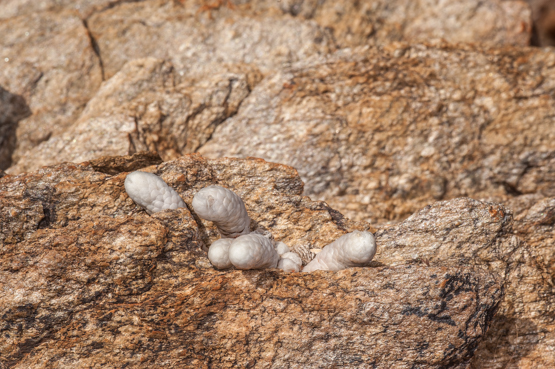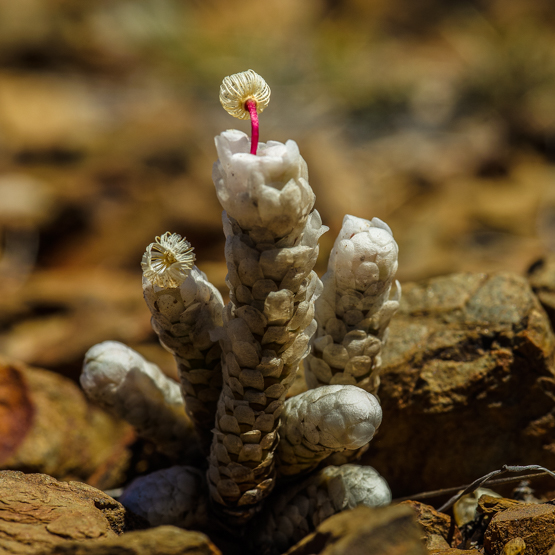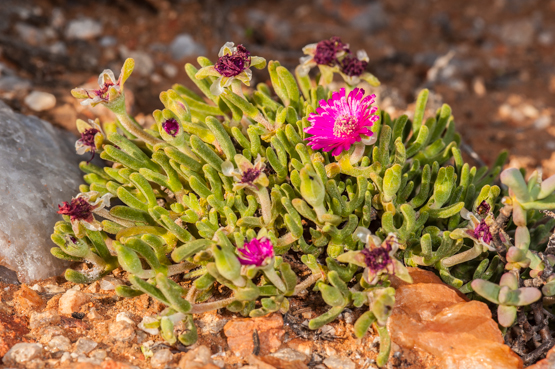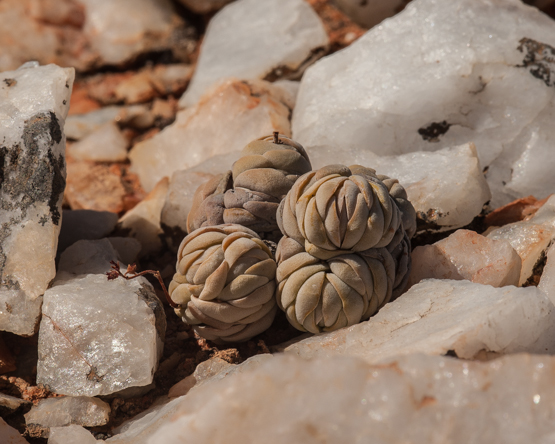These pictures show subspecies namaensis.
Tag: Richtersveld
Avonia papyracea (part 1 of 2)
Even if one has no knowledge of Latin, it is probably easy to understand that papyracea means papery. This refers to the thin, white scales that cover the stems.
These scales are in fact modified stipules: outgrowths of the base of the leaf stalk. By reflecting and diffusing light, they act as sunshades. This effect, combined with controlled aeration*, reduces evaporation. The scales are also able to trap dew.
*It has been noted that in hot, dry conditions the scales tightly overlap each other like roof tiles, whereas in cooler and therefore damper weather they can open out to some extent so that the leaves are more exposed.
As Gordon Rowley in “Anacampseros, Avonia, Grahamia” (1995) remarks, it seems surprising that such an efficient adaptation has, apparently, evolved only once.
The scales are about 5 mm long and wide and hide the minute leaves.
The stems are usually about 5-8 cm long and 0.7-1 cm thick, arising from a thickened tuber. As in other Avonia species, the stems that carry flower buds grow more or less horizontal, but become erect on the day of flowering and stay that way until the seeds have been dispersed.
The scented flowers are creamy white and appear in late spring and early summer.
There are two subspecies: subsp. papyracea occurs throughout the Little Karoo and is also found in the Great Karoo, whereas subsp. namaensis occurs in southern Namibia, the Richtersveld and Bushmanland. Both subspecies seem to feel most at home amongst white quartz pebbles.
According to the literature the main difference between the two is that in the first one, the edges of the scales are entire (without any teeth or other incisions) and in the second one saw-edged to toothed.
The following pictures show plants of subsp. papyracea.
Meyerophytum meyeri
These peculiar plants produce leaves of two kinds: the first pairs of the season are egg shaped, forming a bilobed body; the second ones are much longer than wide, with the leaves free for about two thirds of their length.
The plants are cushion-shaped and up to about 30 cm in diameter. They are found from the Richtersveld to southern Namaqualand, in loamy soil, often with quartz pebbles.
The flowers appear in winter and are either dark pink throughout, or rose with a white base, or white (turning pink with age).
The first two pictures were taken 6 Sept. 2010 (look at the Crassula elegans and Conophytum saxetanum keeping the first plant company)

The flowering plants were photographed 11 July 2011
Adromischus filicaulis (part 1: ssp. filicaulis)
Pelargonium crithmifolium (2)
In the preceding post I mentioned the persisting inflorescences that are so characteristic of this species. When you look back at that post you will notice that even young plants produce them.
One cannot help but wonder what purpose these outgrowths serve apart from the obvious one: supporting the flowers and fruits (which could be done with a far less complicated and heavy structure). We have to bear in mind that these plants live in difficult circumstances and cannot afford unnecessary extravagances. In other words, there must be a proper return on investment and the best return would be one that helps the plants to survive.
To my mind, the persisting inflorescence has three functions:
— It keeps browsing predators away.
— It helps shade the plant and thereby lower the temperature.
— The intricate structure of branches diminishes the speed of the usually hot and desiccating wind.
It is interesting that these functions have their strongest influence at the place where they are most helpful: the growing tips of the stems, with their soft and tender young leaves.
More pictures to follow.
Didelta carnosa var. tomentosa
When we think of succulent members of the enormous Asteraceae (Compositae) family, almost automatically the genus names Othonna and Senecio pop up. Some people will also be acquainted with synomym names like Kleinia, Curio or Notonia, but that is probably it.
Browsing through the Dicotyledons volume of The Illustrated Handbook of Succulent Plants will reveal quite a few more names of genera containing one or more succulent species. One of these is the subject of this post.
Didelta carnosa is the one succulent member of the genus and occurs in southern Namibia and the northern part of South Africa. When flowering it is quite a showy plant, with flower heads up to 9 cm across. In var. tomentosa the leaves -or at least the young ones- have a silvery white woolly cover. The plants grow near to the sea.
(The pictures were taken at McDougall’s Bay, where the plants are accompanied by Fenestraria rhopalophylla ss. aurantiaca, Crassula atropurpurea var. cultriformis and other interesting little succulents).
Pelargonium klinghardtense (2)
Pelargonium klinghardtense (1)
This species occurs on both sides of the Orange River, from the Klinghardt Mountains in the northwest to Witputs in the east. With an annual rainfall of about 70 or 80 mm (occurring in winter) this is a very dry area. In many years there is even hardly any rain at all. The good news is that the meager amount of rain is supplemented by early morning mists throughout the year.
The plants grow on or against rocky outcrops, more or less in the open. They flower mainly between May and September.
Crassula alstonii
It is probably safe to say that C. alstonii cannot be confused with any other plant species because of its unique appearance. The leaves are arranged in two rows and closely adpressed – at least in nature; in cultivation this is difficult to maintain. Each of the almost spherical rosettes is 2-5 cm in diameter.
The plants are found in northern Namaqualand, from just south of Lekkersing to near Komaggas, where they grow on low, gently sloping hills usually covered with quartzite gravel. This is a rather restricted distribution area, but in some places the plants are quite common.







































